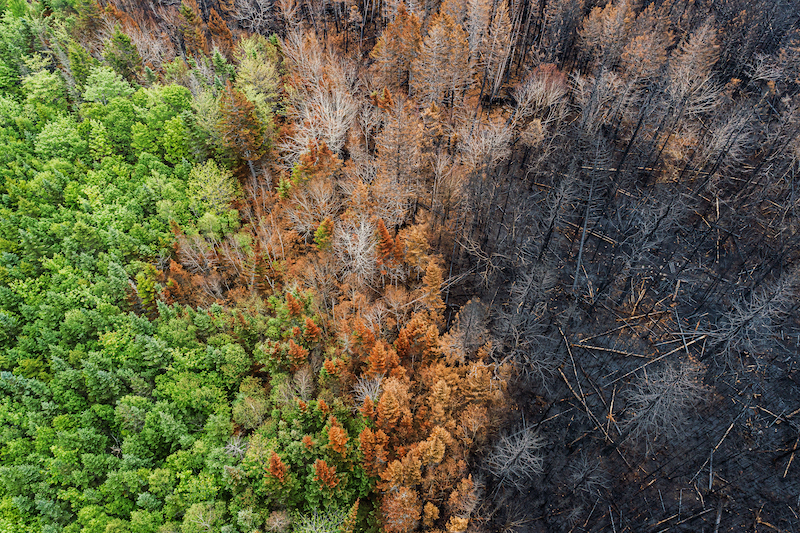


Hope from ashes
Photos by iStock and Kathy F. Atkinson August 19, 2025
UD’s Chiu studies capacity of wildfire chars to suppress methane
It's hard to believe that there is anything positive that could come out of wildfires. They have devastated homes, taken lives, erased memories, leveled cities and destroyed our forests and wildlands. But a University of Delaware professor has found that there is something of value to be learned from what’s left behind in the remnants.
The charred debris left in the wake of wildfires, such as those currently burning in Colorado, Canada and Arizona’s Grand Canyon National Park, is known as wildfire char. UD’s Pei Chiu, professor of civil, construction and environmental engineering, studies wildfire chars and the ways they just might prove useful in reducing methane, a powerful gas that traps heat in the atmosphere. Methane emissions come from many different sources, ranging from livestock manure to landfills and wastewater treatment plants.
This work also informs his research on biochar — man-made chars created from leftover wood chips, rice husks, corn stover and other agricultural biomass — that can be used in soil amendments, stormwater treatment and other applications.

Below, Chiu shares with UDaily five important facts about char — both natural (wildfire char) and manmade (biochar). He also discusses his team’s recently published research in Environmental Science and Technology, a peer-reviewed journal of the American Chemical Society, detailing the potential of wildfire chars to suppress methane produced by microorganisms. Co-authors on the paper include UD doctoral student Jiwon Choi and Danhui Xin, a former graduate student in Chiu’s lab, now at Southern California Coastal Water Research Project.
Q: What is char and where is it found?
Chiu: Char is a carbon-rich material formed at high temperature. In nature, chars are produced through wildfires (i.e., wildfire chars). Biochar, or manmade char, can be produced in a laboratory or commercially by heating surplus biomass, such as wood chips, leftover corn stalks or other crop residues at high temperatures in an oxygen-limited environment, through a process called pyrolysis. In agriculture, biochar is commonly used as a soil amendment to improve soil quality and productivity. It also can be incorporated into compost and filtration systems, among other uses.
Q: Why are you studying char?
Chiu: We discovered a few years ago that heating up plant biomass through pyrolysis can create a large capacity in biochar to reversibly accept and donate electrons. This capacity, called electron storage capacity, plays a key role in biological metabolism. When you run, for example, electrons are exchanged between sugar molecules in the body and the oxygen you breathe to create energy. If you need energy faster than you can take oxygen in, the body ferments the sugars for energy instead.
Microbes do the same thing. When there is no oxygen for microbes to breathe (exchange electrons with), fermenting microbes take over. This often leads to products we don’t want, like methane, in landfills, cattle, wetlands, rice paddies, waste digesters, swamps and other oxygen-depleted environments. Our recent work shows that all chars can serve as oxygen for microbes to breathe and grow, allowing good bacteria to outcompete fermenting microbes called methanogens that produce over 50% of the global methane, and suppressing methane formation in the process.
Q: What does this have to do with wildfires?
Chiu: Wildfire chars have been part of the global carbon cycle for millions of years. We hypothesized that microorganisms must have evolved the ability to metabolize, or process, chars. If true, this novel biological role of chars would have many important implications and applications in biogeochemistry, global climate, contaminant fate and environmental cleanup. While this benefit will never outweigh the detrimental effects of wildfires, both human and environmental, it is something we can learn from and leverage in our effort to mitigate the impact of greenhouse gases.
Q: What has your latest work shown?
Chiu: My group recently published a paper, showing that all chars have a significant electron storage capacity (ESC). For example, wildfire chars and biochars can store a few billion trillion electrons in a gram (about a quarter teaspoon) of char. Agriculture in the United States generates approximately 140 million dry tons of crop residues every year. Corn stover and wheat straw are the main contributors. In addition, forestry generates between 60-70 million dry tons of biomass annually. So, that’s a lot of storage capacity. Meanwhile, common soil microbes can grow by respiring or "breathing" char for energy, something they have likely been doing for eons without us knowing.
Q: Why is this important?
Chiu: All wildfire chars and plant-based biochars can suppress methane. By supporting the growth of char-breathing bacteria, wildfire chars enable these microbes to outcompete methanogens. This is important because methanogens produce over 50% of the global methane today, a major greenhouse gas that is 85 times more potent than carbon dioxide and contributes to over 30% of the current warming. Enlisting microbes with the ability to breathe chars to help us combat this challenge is both smart and sustainable — since these microbes are common in nature and can use the same char repeatedly to suppress methane production again and again. Microbes with the ability to use char for energy can do other things, too, like prevent arsenic from entering drinking water and food crops, and remove pollutants such as nitrate and perchlorate, from stormwater and groundwater.
What keeps you passionate about this research?
Chiu: What really motivates me is the science. Chars collectively represent an enormous rechargeable and bioavailable reservoir of nearly a trillion-trillion-trillion electrons that we inject into the global biogeochemical cycle every single year. Never heard of a trillion-trillion-trillion? It’s a one, followed by 36 zeros. We did not know this until now, but microbes have been eating and breathing chars for hundreds of millions of years. But how? How do they eat or breathe a piece of solid — repeatedly?
Globally, the research community has focused for a long time on reducing carbon dioxide from the environment. Carbon dioxide stays in the environment for anywhere from 50 to 200 years, so if today’s solutions are successful, my great-great-grandchildren will benefit. Methane is 85 times more potent than carbon dioxide, and its lifespan in the environment is only 11.8 years. If we can find ways to reduce methane in the environment, I could live to see the impact in my lifetime.
Contact Us
Have a UDaily story idea?
Contact us at ocm@udel.edu
Members of the press
Contact us at mediarelations@udel.edu or visit the Media Relations website

